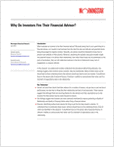Customer complains are a fact of life for financial advisors of all stripes. Sometimes, they can be seen from a mile away. Other times, they come out of nowhere. But in either case, regulators expect advisors to have policies and procedures in place for handling client disputes.
Related: 3 rules for serving customers online
According to Ara Jabrayan of RIA Compliance Group, advisors should first define their definition of “complaint.” Then, a disagreement with a client falls within the parameters of that definition, it should trigger a formal complaint handling procedure.
Step one should typically involve informing the firm’s chief compliance officer that a client complaint is “on the table.” Formal notice should include either at the outset or soon after submission of all relevant documents relating to the client dispute. The involved parties in the firm should also submit description of the disagreement as well as events leading up to the conflict.
Once all files and explanations have been filed, the chief compliance officer should fully investigate the matter and then attempt to resolve it to the satisfaction of all parties. At the same time, the COO should notify the firm’s E&O insurance carrier of a potential claim.
After the COO decides how to resolve the complaint, he or she should formally notify the client and all parties involved within the firm.








 January 19, 2017 at 06:54 AM
January 19, 2017 at 06:54 AM










